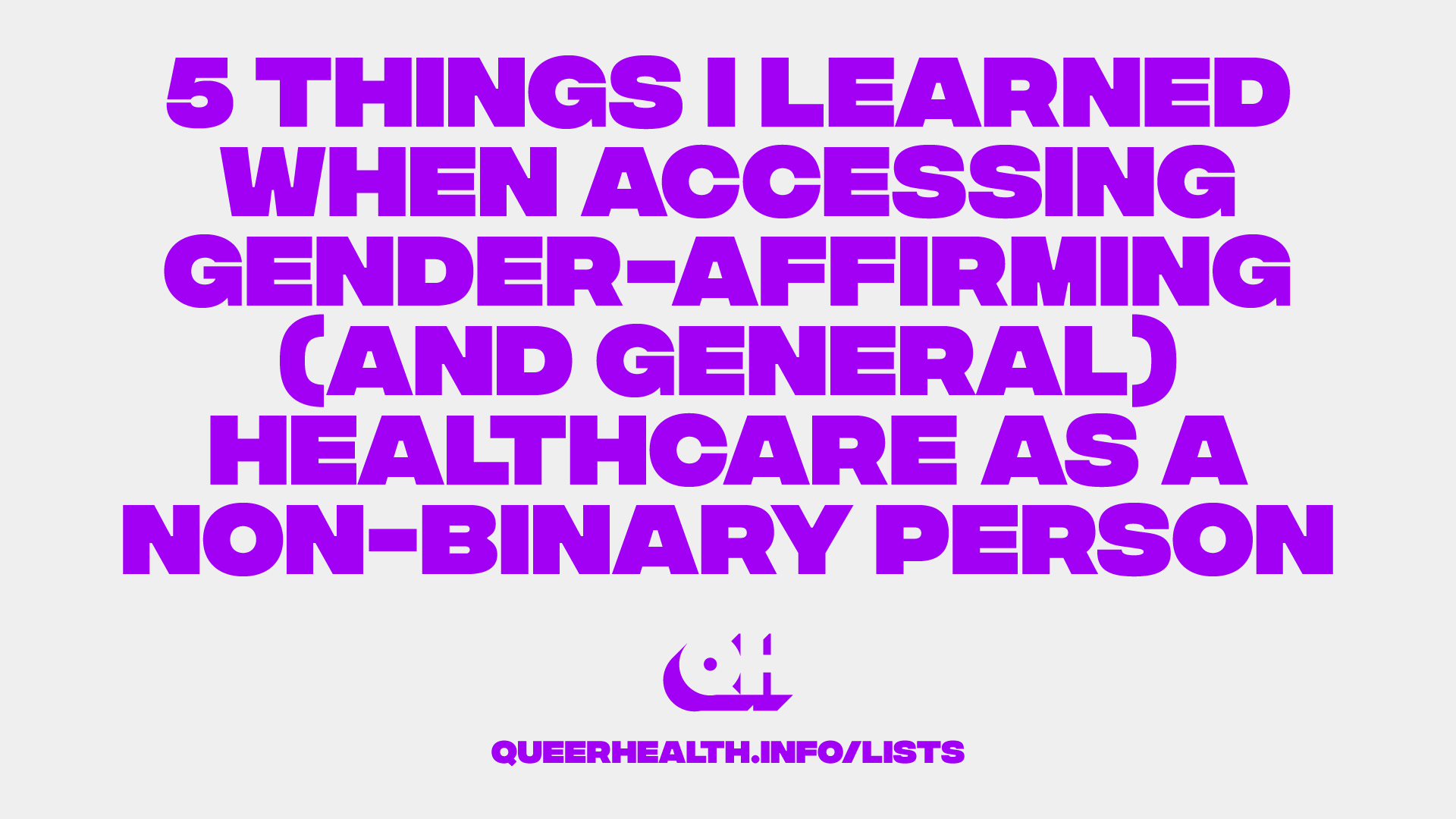
QH LISTS
5 things I learned when accessing gender-affirming (and general) healthcare as a non-binary person
There is no blueprint to follow!
5 things Dani Dinger learned when accessing
gender-affirming healthcare as a non-binary person.
-
-
-

Dani
WEBSITE: danidinger.com
-
-
1. There is no blueprint to follow – take your time, don’t feel pressured to follow one!
If you’re accessing transition related healthcare on the NHS, the system is still very skewed towards binary identities (though this is starting to shift now), and follows a completely arbitrary order of interventions (usually, step 1: social transition, step 2: hormones, step 3: surgery/surgeries). This one-size-fits-all approach may not fit your transition intentions, and that’s so okay! Through assertive self-advocacy, I was able to access top surgery before deciding whether I even wanted to start hormones, giving me space to get to know my post-surgery body. Advocacy is so key in those early appointments, and having an experienced friend come with you can make all the difference.
2. You don’t have to do it via the Gender Identity Clinic
At the time of writing, I’ve been waiting just shy of four years for my first appointment with an NHS Gender Identity Clinic (GIC). In that time, I’ve accessed all the transition related healthcare I want and need for the time being. It is possible! There are plenty of private options accessible online if you have the resources, but I went down the bridging prescription channel for my hormones.
56T at Dean Street in London has been providing sexual health related care for trans and non-binary people for years. Recently they’ve branched out with TransPlus, a new programme which offers hormone prescriptions, surgery referrals, dysphoria diagnoses and more, for people on a GIC waiting list. Similar pilot programmes will be starting up around the country soon, so check in with your local queer friendly clinic!
3. There’ll be a lot of explaining to do – try not to panic or be disheartened
I had to walk my GP through the prescribing process. She was very supportive but totally unconfident, and very uneasy about prescribing testosterone, which she’d never done before in this context. I printed out the NHS prescribing guidelines for her, I basically drafted my own shared care agreement with 56 Dean Street, who were monitoring my bloods, all whilst giving her a 101-crash course in non-binary identities, at a time when I was still trying to figure it all out myself! Accessing other healthcare came with its own challenges. At one point, a surgeon almost refused to operate on me because of her trans-panic. With some tongue-biting and a great deal of patience, I brought her back round, and then some; not only was she very apologetic, but she immediately started writing her pronouns on her email signature and asking future patients what their pronouns and preferred names were. Progress!
4. Trust your gut – you know yourself best.
You might not have a clearly defined end goal in sight, which can feel unnerving and exciting in equal measure. But when you’re considering permanent or lasting changes to your body, what do you go on when making those big decisions? If you’ve been shoehorned into a mismatched identity for any part of your life, stepping outside of that, rejecting it, and taking agency over your body and identity as a non-binary person can bring up self-doubt, coupled with that ever-present ‘am I trans enough to do this?’ question. YES YOU ARE! You don’t need the validation of anyone to live out your truth, in whatever physical form that means for you. If something feels right for you, or you’re even gently curious, look into it. You’ll know if it stops feeling like something you want to do right now – but remember, that could change in the future. Equally, you can come on and off hormones whenever you like (just make sure you’re doing this safely) – your hormone or surgery status doesn’t dictate your identity.
5. It’s worth it!
There’s no denying that this is a really delicate and challenging process, made infinitely more difficult by a healthcare system that is not always geared towards…. well, care. But! The light at the end of the multiple tunnels is the absolute and genuine euphoria that awaits you when your body starts becoming your body. Those pinpricks of excitement across your skin when you notice a change in your muscle tone or body hair, that shriek of joy (or croak…!) as your voice starts shifting, the huge, deep-seated relief at finding the healthcare combination that works for you after trying every conceivable combination…. and the security in knowing that you have agency and control over your own body, your healthcare, and your identity, after what can be a lengthy and incredibly draining process to get there. Finding community in those shared moments of “did your [body part] start [random unexpected thing] too?” and supporting each other through post-surgery care (V pillows all the way!). Whatever your healthcare intentions, owning your identity in the way that feels right for you connects you to a community that has such authenticity, resourcefulness, care, love, and affirmation. And that’s a side effect they don’t put on the side of the bottle.
